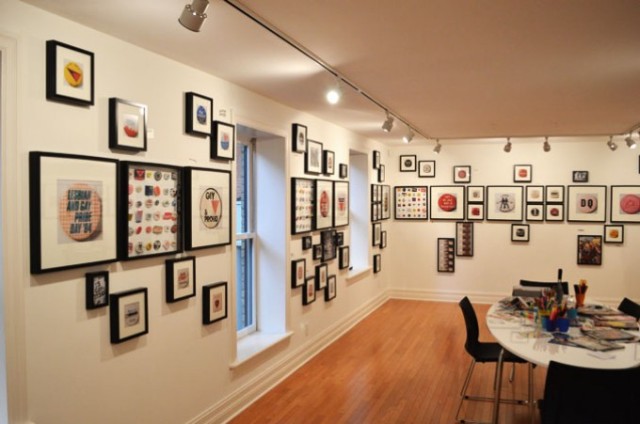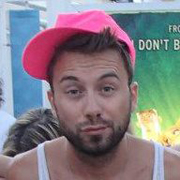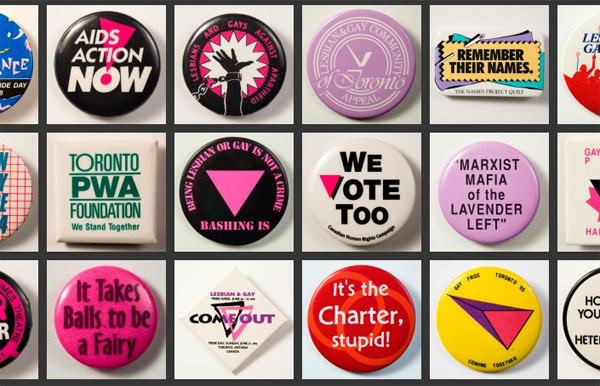Tell us a bit about you- what kind of art do you usually make or what us your artist background?
Most of the artwork I do is photo-based: video and photography. I really tend to focus on the realm of documentary work – on capturing identities, moments, and places that exist as I interpret them. Much of what I do also brings in elements of politics, activism, spirituality, and gay identity. I like to explore traditional ideas and imagery in new ways, offering my viewers a look into my perspectives on life and asking them to examine things in new ways.

What was the inspiration behind your mural? Was it inspired by any other artists or artists work? A key moment in LGBTQ history in Toronto?
The mural I will be creating was inspired by a recent project I developed: The Pin Button Project. This is an online exhibition and oral history project featuring pin buttons from the holdings of the Canadian Lesbian and Gay Archives. The website features photographs of several pin buttons from the LGBTQ+ community, representing a range of decades, causes, organizations, identities, events, and beliefs. Accompanying each button is a brief description and a comments section – intended to serve as a forum for sharing and discussion – a sort of oral history. When I heard about the Church Street Mural Project, I was really inspired to take The Pin Button Project into a new form – a mural – while keeping the elements of audience engagement in this new rendition. I am excited to see how people respond to the wall.
What do you bring to this work- are there parts of the LGBTQ content that is inspired by or comes out of your own background/identity?
What I really like about the mural I’m working on is its incredible inclusivity. With over one hundred buttons being painted – from a range of dates, events, causes, organizations, identities, and beliefs – there is such a wide diversity of representation to be seen. This diversity and inclusiveness was such an important part of its design – I wanted to give each member of our community something to connect with. This desire has come from my own experiences and understanding of the politics of identity and the realities of exclusion.
Tell us about how you made your work ( Medium, creative process, team work etc).
The mural began with the photographing of each individual button (originally for The Pin Button Project). I then spent numerous hours arranging and rearranging the buttons into a design for my wall. I faced so many different possibilities, each which was amazing in its own way, but also challenging to select from. The design needed to have the full inclusion of all the buttons I wanted to incorporate, while also serving as a unified whole in its final design.
What I really like about the design of the mural are its elements of engagement and interactivity. I tried to reconsider the idea of a mural, which is often a 2D, view-only piece of art, and to position this one as a work that engaged its audience, that invited up-close viewing while also encouraging the viewers to interact with it in new ways, and in ways that brought their engagement into a wider forum – online.
When the painting begins, I will be engaging several individuals in contributing to the painting of individual buttons. A select group of community members will have the opportunity to pick a button of their choice and to paint it. I really wanted to enhance the ideas of community participation, of inclusion, and of engagement by involving people directly with the painting.
What do you hope people will take away from your piece?
In seeing this mural, I hope people take away some new knowledge about LGBTQ+ history – especially the struggles faced and achievements made. I hope they take away a new sense of pride, based in a stronger understanding of our community that has so many important root connections while we are also each very unique in our identities. Finally, I hope people take away a bit of excitement on being able to interact with the piece, to become a part of it in a way, and to share their experiences with friends through online channels.
How do you see this project changing or contributing to the Church-Wellesley Village?
I really hope this project contributes to the Church-Wellesley Village by providing viewers with a brief yet broad account of history. I think it can contribute to a better understanding of our community’s history by visitors to the area as well as by younger generations who might be less connected to this important past. On top of that, I think it will add some great colour and impact at the iconic corner of Church and Wellesley.
Read more about the Pin Button Project here.









